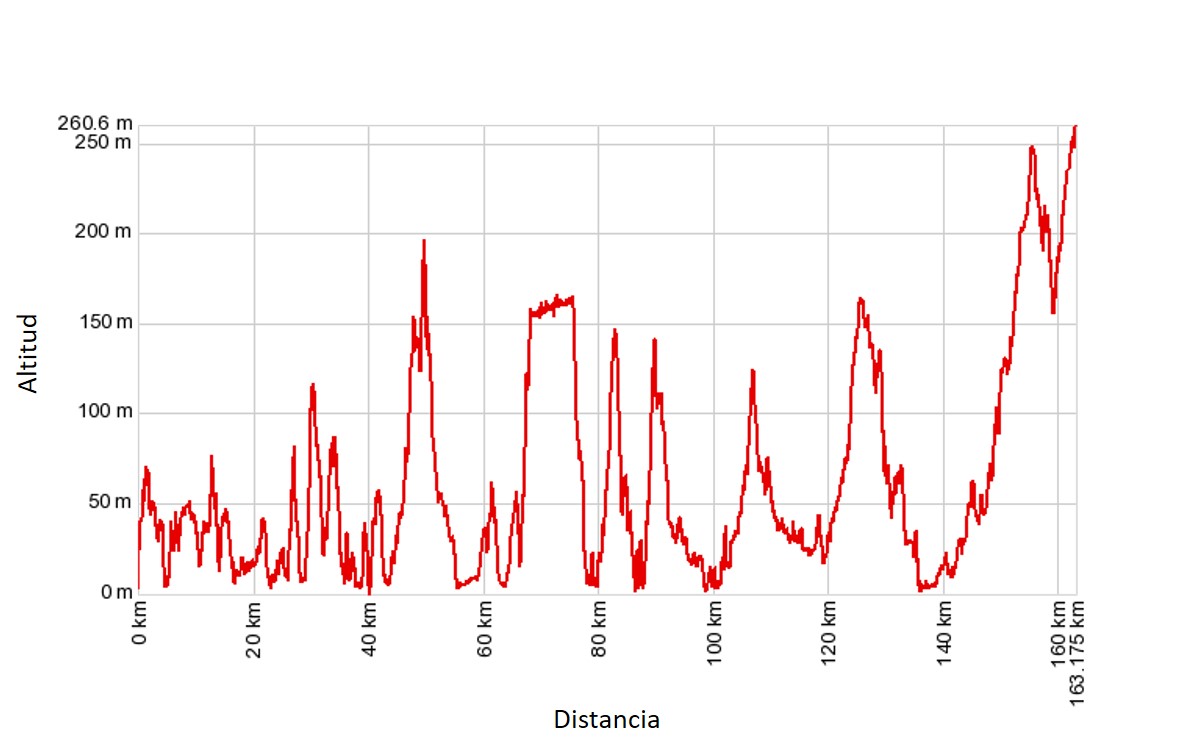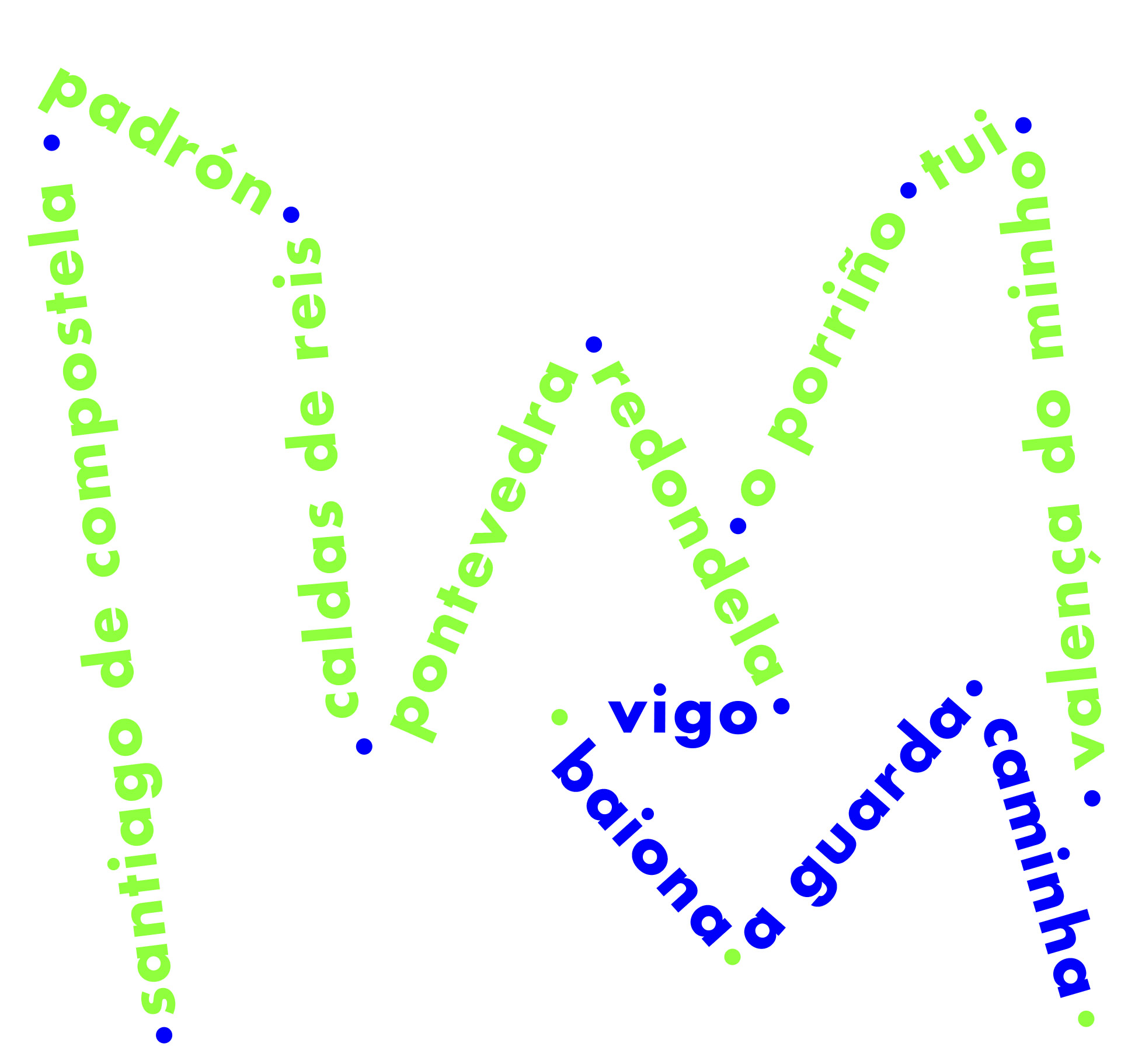the portuguese way (coastal)
The PORTUGUESE COASTAL ROUTE is not a complete route as such, but is rather one of the branches that can be chosen when arriving at Porto from the south. To get to Compostela, it is necessary to walk about 270 km taking the shortest branches (108 km in Portugal and the rest in Galicia).
Porto is the Portuguese capital of the Douro region and is the largest metropolis in the north of the country. The city currently benefits from the presence of the Sá Carneiro airport, with numerous international connections. This, combined with the lure of the sea, explains why this route has grown the most in recent years, becoming the third most popular after the French Way and the Central Portuguese Way, with 6.4% of the total number of pilgrims.
From a historical point of view, it is a rather weak option. Although the coastal route in Portugal has been relatively strong since the 16th century (not in the Middle Ages), in Galicia, it has been less of a reality because, until recently, pilgrims tended to go up the Miño River to Valença to continue through Tui.
The supposedly traditional route that runs through the sands on footbridges, promenades and paths used by fishermen has little to do with the historical Jacobean route, but rather responds to a new tourist concept of the Pilgrim’s Way to Santiago. Despite this, the Xunta de Galicia government, for whatever reason, declared it official in 2016, and its success has been undeniable.
 By the sea you will feel both small because of its magnitude, and big, as you enter into closer communion with nature that humankind has not yet been able to urbanise.
By the sea you will feel both small because of its magnitude, and big, as you enter into closer communion with nature that humankind has not yet been able to urbanise.
The main characteristic of the Portuguese Coastal Way, at least from Vila do Conde, is that it always proceeds close to the coast. It does so starting in Galicia, passing the Miño estuary and the country’s largest city, Vigo, before joining up with the Portuguese Central Way in Redondela.
Aside from the problems caused by storms, and, in general, by any problem related with the proximity of the sea (wind), this route is one of the easiest to walk because there are hardly any slopes. Problems arise more from population density, especially in the area of Vigo, than from topographical rigors.
If we think of the succession of coastal landscapes with their sandy areas, the charm is undeniable. The built heritage is also rich: the fishing port of A Guarda, the monastery of Oia, the monumental town of Baiona or the large urban area of Vigo are proof of this.
As the Way has become more popular, the existing services have been adapted to pilgrims. However, there are still big gaps in terms of welcoming pilgrims. There are, for example, no public hostels in Baiona or Vigo, and the private initiative is not remarkable in this area either.
Walking a daily average of stages, the 80-km route along the coast between A Guarda and Redondela can take about four days, leaving time to stop at the main locations. From Redondela to Santiago through the Portuguese Central Way would require another four days.

HOW TO GET TO CAMINHA OR A GUARDA
If you don’t have time to walk to Porto and can only walk the last stages, we recommend that you at least cross the Miño from Caminha because following the Portuguese Way without Portugal is completely meaningless. Even so, you will miss a number of historical towns of great beauty, such as Vila do Conde or Viana do Castelo.
– You can get to Caminha from Porto, by train from the Campanhã station, 1 h 30 m, fares from 7 euros (www.cp.pt), or by coach with Rede Expressos, from the Campo 24 de Agosto station, from 1h 30 min to 2h 15 m, fares from 9.5 euros. There are also coaches from the Sá Carneiro airport (Porto): the fastest route is by Viana with Andrade Express, in about 1 h 15 m, fares from 10 euros.
– If you arrive by plane at Peinador (VGO), you can go to Vigo by Vitrasa’s bus route 9A. This bus runs every 30 min Monday to Friday, from 5:55 am to 11:07 pm, and Saturday, from 6:40 am to 11:07; on Sundays, the bus runs every hour from 9:30 am to 14:30 pm, then every 30 min from 3:00 pm to 11:00 pm; fares from 1.35 euros. There are stops at Travesía de Vigo if you want to travel on foot to the bus station, 1 km away, and at República Argentina, if you want to get the Vigo Guixar train station, 700 m away.
Once in the city, you can take the train or bus to Valença. There you will have a stopover before continuing to Caminha; it will take more than two hours by train, with two departures per day to Valença, and seven hours from Valença to Caminha, fares from 8–14 euros. It is almost two hours with Rede Expressos; there is one bus per day at 1:30 pm, fares from 9–20 euros.
From Vigo to A Guarda by bus, via Tui and Baiona with ATSA (telephone +34 986 610 255), from 1 h 15 m, fares from 6.05 euros; weekend services are significantly reduced.
– In Caminha, which should take at least a couple of hours, you can take the ferry Santa Rita de Cássia, which crosses the Miño estuary hourly(from 8 am to 1 pm and 2 pm to 7 pm, or 8:30 pm in July and August, fares from 1.50 euros, but is suspended at low tide; updated information at the Tourist Office in Caminha, tel. +351 258 911 348 or the Tourist Office in A Guarda, telephone +0034 986 614 546. The crossing takes 20 minutes and disembarks at A Pasaxe (Camposancos), where the first marks of the Way in Galicia appear.
sections
caminha – vigo

THE CAMINHA–VIGO STRETCH (61.2 km)
description
The canyon of the Miño River (Foz do Minho in Portuguese) makes us reflect on the fact that it is a physical border, not a cultural one, that generated historical vicissitudes of all kinds: wars, smuggling, trade, coexistence, collaboration and pilgrimage. For this reason, we’ve set this as the departure point in Caminha.
The present is the point where past and future join, a frontier station in time, but not different in quality from the two realms it connects. (Erich Fromm)



Having entered Galicia, we prepare to pass the iconic Mount Santa Tegra, crowned by the largest citadel of Galicia and reach the fishing village of A Guarda.
From A Guarda, we will go through a very rough and rocky coastal stretch, first along the old lobster farm to the town of Oia, which is dominated by an unusual monastery by the sea.
Over the same rough path, the Way goes past the Porto Mougás pier and ascends along an old roadway, with a view of Cabo (Cape) Silleiro and its lighthouse, to reach the town of Baiona.
![]()
![]()
![]()
![]()
![]()
![]()
![]()
After crossing the 13th-century bridge of A Ramallosa, we will move away from the coast in the shelter of a beautiful cove, decorated with long sandy beaches. At a prudent distance, we will continue through an increasingly urbanised area, noteworthy for the presence of several pazos (Galician traditional manor houses), the Estea hill fort and the Romanesque church of Coruxo.
As with all cities, the approach to Vigo is a bit traumatic with roundabouts and business parks, although the Way manages to find a discreet path through the neighbourhoods of Comesaña and Matamá.
![]()
![]()
![]()
![]()
![]()
![]()
![]()
Our suggestions
– If you have chosen to start in A Guarda, or are sleeping in the square, try to climb the 341-m high Monte de Santa Tegra on foot (3 km, 1 h). At the top, you will see the large excavated fort, archaeological museum and chapel of the saint, but also an exceptional panoramic view over A Guarda, the mouth of the Miño River and part of the Portuguese coast. If you don’t want to go by train or to do penance (as this route follows a Via Crucis), you can opt for a taxi.



– Lose yourself in the nooks and crannies of the old seafaring town of A Guarda, with its charming corners around the church of Santa Maria and the town hall square with its Clock Tower. You can also go up to the Santa Cruz Castle, which was captured by the Portuguese just after it was built in 1665. End at the port, with an aperitif in one of its taverns.
– In the meantime, the hotel planned in the Monastery of Oia has not yet been built. If you are lucky, you can sign up for a guided tour to see the building, or you can enter the church for free.
– There were two lighthouses at Cabo Silleiro: the lower lighthouse, built in 1866 and not on our route, and, the upper lighthouse, which was built in 1924 but is accessible from the Way, as it is part of the coastal military batteries arranged on the mountain. If you are lucky enough to pass this way at sunset, you will see one of the most famous sunsets in Galicia.
-In Baiona, take time to see some of the many things it has to offer. Enter the fortress of Monterreal, or at least walk around its walled enclosure by the sea. Discover the testimonies of the arrival of Martín Alonso Pinzón and visit a replica of the Colombian caravel. Kick around the old town with the collegiate church of the Anunciada. Get to know the impressive history of the martyr Saint Liberata in her baroque chapel. Go up inside the monumental image of the Virxe da Roca, the work of Antonio Palacios. Enjoy tapas in the historical area, full of bars and inns, or a dolce far niente session in any of the town’s small coves or in Sabarís near the beach of Ladeira.
all about vigo
WHAT TO DO IN VIGO
description
Pilgrim meetings
– Getting your credencial [pilgrim’s passport] stamped at the co-cathedral of Santa María is more than a ritual – it makes you feel like part of a great tradition. In addition, there is the Christ of the Victory in its interior, who appeared floating in the sea next to the Cíes, and is so called because of the help he gave to free the city from the Napoleonic troops on 28 March 1809 – or that is what those who pray to him say. The date has remained so fixed in the collective memory that a large procession is still held in his honour every year.
-The neo-gothic church of Santiago de Vigo, finished in 1907, is located in Rúa García Barbón. Our apostle loves to receive the visits of pilgrims.
The essential sights
– Be sure to walk along Vigo Vello. The humble seafaring origin of the city is apparent in the streets, especially in the porticoes of Ribeira do Berbés, where a pilgrim hostel is being built. The Praza da Constitución in the upper part is a pleasant pedestrian area and, with its terraces, a helpful meeting point.
– Try the oysters from the Arcade in Rua da Pescadería, which are opened by the ostreiras at the very moment they are eaten. Exercise moderation, as the oysters can be difficult to digest.
– Take a stroll around the part of the city overlooking the estuary along the Paseo de Beiramar and the estuary’s maritime station to cross to Cangas and Moaña, or go to the Cíes and see the giant sculpture of the Nadadores (Francisco Leiro). Do not miss the statue (next to the marina) dedicated to Jules Verne, who is shown sitting on the tentacles of a great octopus and who spoke of the treasures of Rande in his 20,000 Leagues Under the Sea.
– Get a quick look at the booming bourgeois Vigo and its early 20th-century stone buildings scattered around the Alameda, Policarpo Sanz, García Barbón (built in 1926, this theatre is an imitation of the Paris Opera), Urzaiz and the commercial Rúa do Príncipe or the Porta do Sol, where the shocking statue of the Sireno (Leiro) stands.
– Finally we depart for the ascent to Monte do Castro, which, in addition to a pre-Roman settlement or vicus, has beautiful gardens and viewpoints.
Our suggestions… Moving around
– The Sea Museum. The content is worthwhile, but the building itself is more seductive, and is a brilliant intervention by the great architect, Aldo Rosi.
– Pazo Quiñones de León. You will pass by the manor house if you have previously chosen the Lagares branch. The building, dating from the 18th century, hosts an archaeology and art museum, but the most sublime feature is its historic garden, which is one of the most beautiful in Galicia. The park of Castrelo, the green lungs of the city, is located nearby.
– Samil Beach. This beach is just like a museum: you don’t have to go to the sand or the water, you can just follow the promenade and discover the magical rocky silhouette of the Cíes Islands in the background.
– Pazo and park of San Roque. Taking the Traída branch, there is a small urban oasis with viewpoints on the estuary, which is a good place to say goodbye to the city.
vigo – pontevedra




THE VIGO–PONTEVEDRA STRETCH (46.5 km)
description



Joining up with the Central Way (from Lisbon) in Redondela, you can admire the Ría de Vigo and arrive at Pontevedra, one of the most significant cities of the Way.
For the time being, to prevent the urban pressure and noise from overwhelming us, the route between Vigo and Redondela has been marked by the Senda da Traída.
![]()
![]()
![]()
![]()
![]()
![]()
![]()
The marks accompany us next to the Fonte das Mozas until the beginning of a path that goes into wooded areas and provides views over the narrowing of the estuary, with the Rande Bridge and the cove of San Simón. In view of the train’s viaducts, the descent to Redondela is rapid.
I see Vigo, I see Cangas,
I also see Redondela,
I see the bridge of Sampaio
in my way to Pontevedra.
(Popular song)
In Redondela, you have to pass under two railway viaducts and by the 16th-century public hostel of Casa da Torre, where you can get your credencial [pilgrim’s password] stamped. The next town is Cesantes, from which we see the placid bay of the Isle of San Simón close to the beach.
A steep slope leads to the heights of Lomba and Cabaleira, followed by the quick descent to the town of Arcade, with the arrival at the long Pontesampaio Bridge, which crosses the Verdugo River.
 On the contrary, the city provides us with an immense opportunity to enjoy in all senses. ‘He who does not know how to enjoy fortune when it comes, should not
On the contrary, the city provides us with an immense opportunity to enjoy in all senses. ‘He who does not know how to enjoy fortune when it comes, should not
It is amazing that, in such a developed area, the Canicouva roadway may have survived almost intact on the way to Pontevedra. You can follow one road from the chapel of Santa Marta, but there is another worthy and beautiful alternative. The entrance to the city of Pontevedra seems endless, but the old town ultimately makes its appearance and it is the best place to stay if you have the chance.
![]()
![]()
![]()
![]()
![]()
![]()
![]()
Our suggestions
– Step by step, enjoy walking the path Senda da Traída. The path is a permanent viewpoint over the estuary, with long stretches of land, streams coming down from the mountain and dense trees. It is an unexpected wonder!
– Consult the timetable for trains passing through Redondela. If you have time on your hands, it is worth seeing the railway pass slowly through overhead the viaduct of Pontevedra, built in 1884, above the houses. Its big brother, or the viaduct of Madrid, has earned a well-deserved rest.
– It is almost a ritual to taste the oysters, in Arcade, whose oyster bed served the palates of kings and courtiers. The oysters are cultivated in pans and, shared between two people, they go in a flash.
– The cannons of Pontesampaio still resound. Situate yourself in the War of Independence: Marshal Ney’s veteran troops on one side and the poorly organised resistance of guerrillas, patriots and students on the other, armed with wooden cannons that burst at the second shot. Well, just as sometimes happens in football, David won, and the gabachos retreated.
all about pontevedra
WHAT TO DO IN PONTEVEDRA
description
Pontevedra is a good town, quenching the thirst of anyone that is wandering through the Ferraría fountain… (popular medieval song)
…but not only with water.
Pontevedra is a fascinating city that deserves at least one full day of our journey, which allows you to get to know the old town, the Pilgrim’s Sanctuary, the entertaining provincial museum, local parks, tapas area, and so forth.
Pilgrim meetings
– Pilgrim Virgin Sanctuary. Built in 1794 by order of the Refuge and the Divine Pilgrim brotherhood, the temple stands on a scallop-shaped floor, and it has a convex façade. This was unbecoming for a neoclassical style, but still shows appreciation for the Baroque. The image, in her dressing room, seems to be dressed for a dance at Versailles at the court of Louis XV. Masses: daily at 7:30 pm (for pilgrims), 1 pm on Sundays and holidays.
The essentials
– Such an incredible old town! Could Santiago overcome it? Perhaps in terms of monuments, but not so much in terms of harmony and neatness. In Pontevedra, everything is impeccable, and you can’t even see any cars. The city has been honoured many times, with awards such as the European Mobility Award (2013) or the UN Habitat (2014). Places like A Ferraría and, above all, A Leña, are sites that you will not forget. It is best to walk in a leisurely fashion, and leave the walled almond groves to prolong our steps along the 19th-century boulevard.
– Church of Santa María. This church belonged to the guild of thugs and now bears the title of minor basilica. Here the final Gothic or Elizabethan style, Manueline dressing and the plateresque style of the main façade converge without stridency.
– The Pontevedra Museum. This is an authentic leader for Galician culture, organised in no less than six buildings from different periods. Its collections are extremely varied: from prehistoric treasures to statues from the Portico da Gloria, and from the best classical paintings to the decorative arts, including Sargadelos ceramics, works by Castelao and other Galician artists and even a reproduction of the cabin of the frigate Numancia.
Our suggestions
– At midday, go to the food market where, in addition to discovering seafood from the estuary of Pontevedra and the Atlantic, you can eat on the upper floor, which has been an interesting gastronomic space since 2019.
– If you like classic cafés, don’t forget to go to the Moderno, decorated with paintings, where the Galician intelligentsia met in the first decades of the 20th century.
– You can also go for a few glasses of wine, beers and tapas in the old town, one of the best places in Galicia to practise this healthy pastime. The number of choices is immense, with close to 300 bars!
– If you stay one more day in the city, cross the river to A Xunqueira and visit the great park of A Illa das Esculturas, where you can find up to 12 great artistic works by the best contemporary creators.
![]()
![]()
![]()
![]()
![]()
![]()
![]()
pontevedra- santiago




THE PONTEVEDRA–SANTIAGO DE COMPOSTELA STRETCH (65.2 km)
description


We leave Pontevedra across the Burgo Bridge, which was already in place during Roman times, to continue from the xunqueiras de Alba to the church of Santa María de Alba. In parallel with the railway, we enter a wooded area traverses the vineyards of Barro.
The route is marked with a series of crosses and approaches the paradisiacal enclave of Muíñada de Barosa, formed by a group of mills around waterfalls and pools for bathing.
We reach the thermal village of Caldas de Reis on level ground under the wine arbours. From Caldas de Reis, the forest gains ground accompanying the Bermaña River until Carracedo and then by descending to the Valga River until reaching San Miguel a little further on.
We say goodbye to the province of Pontevedra by skirting the town of Pontecesures and crossing the Ulla River heading to Padrón, the true cradle of the Jacobean tradition.
![]()
![]()
![]()
![]()
![]()
![]()
![]()
There are a number of interesting places on the way between Padrón and Santiago. First is the old cathedral of Iria Flavia and then the Marian sanctuary of A Escravitude, with its holy fountain, shortly after the palace of Faramello. Nearby, one can also see the Castro Lupario and, a little further on the Rúa de Francos calvary, there are surviving native woods that continue to fascinate.
The area from Osebe to Santiago de Compostela is very urbanised, especially from Milladoiro. The towers of the cathedral of Santiago de Compostela are visible here for the first time.



The entrance to the city of Santiago de Compostela is close to the ruins of the castle of A Rocha Vella, which is located in front of the monastery of Conxo, which leads to the Porta Faxeira and the cathedral.
Our suggestions
– The diversion to the Muiñada de Barosa is minor, but the reward is enormous. You will be able to refresh your feet in its pool, be enraptured by the beautiful waterfall and eat in the picnic areas arranged in the shade or in a tavern settled into a mill. These are the Way’s little surprises – pleasures that are always remembered.
– In Caldas de Reis, which will soon have public thermal pools for bathing, there is a great botanical garden next to the Umia River, which is perfect for a relaxing time.
– Padrón is a compendium of the Jacobean legend, including the church of Santiago, which is full of Santiago’s iconography. Under the main altar, the pedrón is a must see: the disciples of Santiago tied their boat to this Roman altar. On the other side of the river, you can ascend to the chapel of Santiaguiño do Monte, where the apostle would have preached and where he made a fountain spring up between the rocks.
…The disciples of St. James, jumping on the ground, tied it [the boat] to a thick stone pillar that was in the landing stage, which is now in the Church of St. James. It is two hundred steps from this landing stage, under the main altar, which is visited and revered by all pilgrims. (Mauro Castellá Ferrer, 1610)
– The most glaring example of the literary dimension of the town of Padrón (Macías O Namorado by Camilo José Cela) is Rosalía de Castro, a true monument of Galician Literature. The House Museum of Rosalía de Castro, 1 km away from the centre, is a real sanctuary. If you want to get to know the soul of Galicia, don’t forget to visit this museum – you will understand many of the keys to the country you are visiting.
– If you enter the former cathedral of Santa María de Iria, you will discover its Gothic door, its stepped towers inspired by the Aztec pyramids, such as those in the cloister of the cathedral of Santiago and, by its side, the melancholy cemetery of Adina, where the Nobel Prize winner Camilo José Cela lies.
– If you want to stay healthy, drink water from the fountain of the sanctuary of A Escravitude. The staircase raised on this sanctuary leads to a prodigious baroque façade, similar to that in the cathedral of Santiago de Compostela, but on a different scale.
– Before going up the stony road to O Faramello, we recommend another diversion to the great Castro Lupario (600 m), which is associated with an evil queen who did everything she could to obstruct the burial of the apostle, but who ended up being converted. This diversion features a large archaeological site surrounded by carballeiras.







